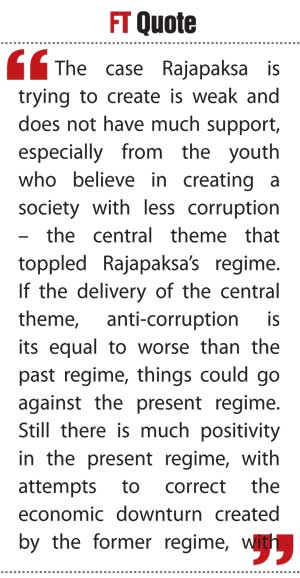Thursday Jan 02, 2025
Thursday Jan 02, 2025
Saturday, 9 April 2016 00:00 - - {{hitsCtrl.values.hits}}
 By Asanga Abeyagoonasekera
By Asanga Abeyagoonasekera
On Easter Day, a day of rejoicing and celebration for Christians, shrapnel and ball bearings pierced through innocent civilians in a children’s park in Lahore, where a majority of the victims were children. This disgraceful suicide attack, which killed 69 and injured nearly 400, was a sad day for Pakistan and the region. Days before, another terrorist attack, in Brussels, targeted innocent civilians.
The world has become unstable due to terrorism across the globe and the highest priority on the global agenda should be towards combatting it. Without a safe environment, it is difficult to talk economic prosperity, a lesson Sri Lanka learned from its brutal three-decade war. The physical and mental scars that terrorism causes are deep. They are not easy to forget as victims.
For this, consensus at the highest political level is important. The daunting task of bring the two different political parties with different values – United National Party (UNP) and the Sri Lanka Freedom Party (SLFP) – together, was established a year ago in Sri Lanka.
The recent developments within the political party of President Sirisena have not been so positive, with some members being questioned for supporting the former President Rajapaksa at a rally organised in Colombo’s Hyde Park. With the recurring electricity failures, the advantage has moved to the former President, with the creation of the slogan ‘Rajapaksa is the President of the street and Sirisena President of the country… give it to me if you can’t’.
Sri Lankan civilian engagement with social media on this has been negative, especially given the billions of losses incurred by SriLankan Airlines being exposed by a Government Minister. The sentiment is, ‘we have given you the power, so fix it’.
 High expectations
High expectations
and promises
High expectations and promises were set at the beginning, and the delivery has been slow but steady. From 8 January 2015, beginning with the 100-day reforms, until now, demonstrates 16 months of the new Government.
The Right to Information (RTI) Act was tabled in Parliament last week – a considerable achievement – but this needs further amendment as it prevents access to some important areas that de-feat its main purpose. The RTI act could take a considerable amount of time to take the proper shape, as it did in India, with many amendments and public debate. This exercise would have been impossible un-der the former regime with its control and censorship of the media, and attacks on media outfits and individuals.
Some people are now looking at change that could bring back the former regime. They tend to forget the environment of the past where power revolved around one individual who took over the independent commissions, including the bribery commission, under his control, further extending Rajapaksa’s political term by more than two terms. His once powerful family member has now taken a back seat at the Hyde Park rally, giving front seats to other SLFP seniors, which was not the practice in the past as all the senior party members had to get the blessings from the family member.
One senior Minister and a party leader, now a supporter of Rajapaksa, who had a small Ministry office and a nominal budget, showed his displeasure during the Rajapaksa period but is now a frontrunner in the campaign to bring Rajapaksa back to power. Another senior politician from SLFP who got many more votes than several other candidates elected from the national list spoke to this author of his displeasure at the giving of positions to the rejected lot by the people.
Praise for the Government’s efforts
Despite all obstacles, the triple power centres of the Government – President Sirisena, PM Wickremesinghe and former President Kumaratunga – have found a working order for some crucial subjects despite their differences and public disagreements with one another, which is a great achievement. Even within the Government, a Sirisena faction Minister recently made some harsh comments against the Prime Minister, calling him an enemy of the SLFP, which angered the UNP Ministers.
Internationally, there has been much praise for the Government’s efforts to move towards introducing good governance, minimising massive spending, and working towards a more citizen-centric government. The colossal spending included expenditure for State events, foreign visits filling entire flights, establishing overseas missions at places that have no direct benefit for Sri Lanka. Now, restructuring in all these areas can be seen, and they cannot be fixed overnight.
The case Rajapaksa is trying to create is weak and does not have much support, especially from the youth who believe in creating a society with less corruption – the central theme that toppled Rajapaksa’s regime. If the delivery of the central theme, anti-corruption is as equal or worse than the past regime, things could go against the present regime. Still there is much positivity in the present regime, with attempts to correct the economic downturn created by the former regime, with massive loans and financial misappropriation at all levels.
A perfect balance in Sri Lanka’s foreign policy will be sought after the PM’s visit next week to China, “a time-tested friend” that has assisted the country during many difficult times. Geo-strategically well positioned with its centrality in the Maritime Silk Road, Sri Lanka will thrive economically if this perfect foreign policy balance is achieved.
[This article was initially published by the Institute of Peace and Conflict Studies (IPCS) New Delhi for ‘Dateline Colombo’ (http://www.ipcs.org/article/south-asia/politics-of-promise-between-sirisena-and-rajapaksa-5012.html).]